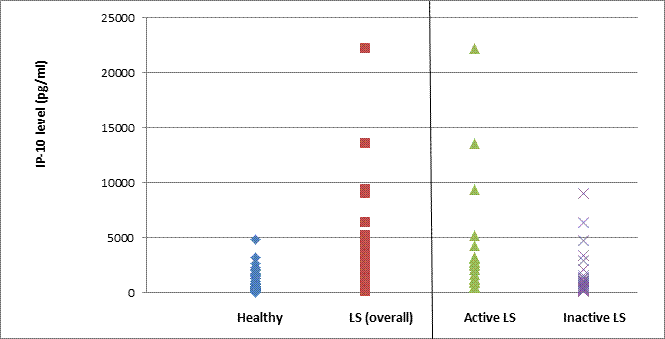Session Information
Session Type: Abstract Submissions (ACR)
Background/Purpose:
Pediatric localized scleroderma (LS) is an autoimmune disease affecting the skin and underlying tissue. Cutaneous findings assist in categorizing the patients into active or inactive (predominately damage) disease states. The biopsies of those with active disease features demonstrate a lymphocytic infiltrate. T helper (Th) lymphocytes and their associated cytokines have been identified in the tissue and in the peripheral circulation of patients with scleroderma. This study was designed to evaluate the levels of Th-associated cytokines and chemokines at various stages of LS, with a particular focus on active disease and its clinical parameters.
Methods:
Plasma samples were obtained from 69 pediatric LS patients and 71 healthy pediatric controls. Several cytokines and chemokines were evaluated using a Millipore luminex panel comparing LS to healthy controls, with additional analysis predetermined to be dedicated to LS patients with active disease. LS patient samples were categorized as either clinically “active” or “inactive” at the time of collection. Active disease was defined by the presence of new, enlarging, erythematous lesions and a Physician Global Assessment of Disease Activity (PGA-A) score greater than zero. Nonparametric statistics were employed comparing cytokine levels between LS and healthy groups and between active and inactive LS patients (α = 0.05).
Results:
IP-10 levels were significantly elevated in LS patients compared to healthy controls, u = 4.785, p < .001, as well as in LS patients with active disease compared to inactive disease, u = 3.305, p = .001 (Figure). Also, IP-10 levels were elevated in patients with new lesions, a variable strongly reflecting disease activity (trending toward significance, p = .057). IP-10 levels were also significantly correlated to two well accepted disease activity outcome measures, the modified Localized Scleroderma Skin Severity Index (mLoSSI) (ρ = 0.343, p = 0.004), a quantitative assessment of disease activity, and the PGA-A (ρ = 0.450, p < 0.001).
|
|
n = 71 |
n = 69 |
n = 30 |
n = 39 |
|
Median (pg/mL) |
445.8 |
1140.34 |
2087.25 |
880.5 |
|
IQR (pg/mL) |
246.0 – 833.5 |
497.9 – 2495.7 |
956.6 – 3099.0 |
447.8 – 1289.8 |
Conclusion:
Our previous serologic analyses as well as studies in systemic sclerosis have identified gamma interferon-induced protein-10 (IP-10) as a potential molecule of interest in the pathogenesis of scleroderma. An elevation of plasma IP-10 levels in pediatric localized scleroderma (LS) when compared to those of healthy controls further supports these findings. Analyses demonstrating IP-10 elevation in patients with active disease and correlations with valid activity measures suggest that IP-10 may be a biomarker for disease activity in LS.
Disclosure:
K. Kurzinski,
None;
C. A. Feghali-Bostwick,
None;
C. Kelsey,
None;
K. Magee,
None;
K. S. Torok,
None.
« Back to 2012 ACR/ARHP Annual Meeting
ACR Meeting Abstracts - https://acrabstracts.org/abstract/gamma-interferon-induced-protein-10-ip-10-as-a-potential-biomarker-for-disease-activity-in-pediatric-localized-scleroderma/

